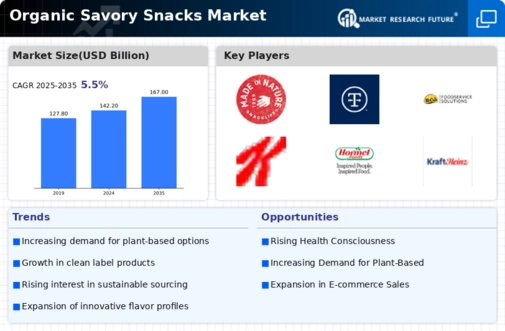Market Share
Organic Savory Snacks Market Share Analysis
Businesses use a variety of market share positioning techniques to establish themselves and obtain a competitive advantage in the thriving organic savory snack sector. One noteworthy tactic is differentiation, in which businesses concentrate on producing distinctive and superior-quality organic savory snacks in order to set themselves apart from rivals. To appeal to customers that care about the environment, this may entail utilizing premium organic products, adding unusual tastes, or highlighting ethical and sustainable sourcing methods. By forging a unique identity, businesses want to attract a particular market niche and cultivate brand loyalty among customers looking for more environmentally responsible and healthful snack alternatives.
Another crucial tactic is cost leadership, especially in marketplaces where consumers' decisions are heavily influenced by price. Businesses that use this strategy focus on streamlining production procedures, effectively procuring organic ingredients, and guaranteeing affordable packaging. Offering premium organic savory snacks at affordable rates allows companies to reach a wider audience and maybe improve market share through higher sales volume. Keeping a competitive advantage also requires alliances with reputable organic suppliers and a dedication to economic and ecological operations.
A popular tactic is market penetration, which is making attempts to raise the market share of currently available savory organic snack goods. To get a bigger share of the present market, businesses step up their marketing campaigns, widen their distribution networks, and run discounts. This might involve joint ventures with merchants, well-planned marketing initiatives, and product placement to raise brand awareness and persuade more customers to pick their organic snacks over rival brands. The objective is to maintain the company's leadership position in the organic savory snack industry and increase sales within the present market. On the other hand, market development concentrates on investigating unexplored areas or presenting tasty organic snacks to new consumer groups. Businesses who use this approach locate untapped markets or areas with a potential demand for natural and organic snacks. Through comprehension of the distinct dietary requirements and preferences of these unexplored markets, businesses may customize their products and services to draw in new clients. Product adaptation is frequently necessary for market development in order to match the unique preferences and interests of the new target market. Another tactic used by businesses to gain market share is diversification, which involves expanding their product offerings beyond conventional organic savory snacks. This might entail offering novel tastes, creative packaging, or coordinating goods like spreads or dips made from organic ingredients. Companies may better serve a wider range of customer demands through diversification, which lowers the risk of depending just on one product category and increases total market share. To sum up, the Organic Savory Snacks Market exhibits a wide range of tactics meant to acquire a competitive edge and grow market share. Organizations employ several strategies such as differentiation, cost leadership, market penetration, market expansion, or diversification to effectively manage the complex market dynamics and satisfy customer preferences for natural, organic, and sustainable savory snacks. A thorough grasp of customer preferences, a dedication to ethical and organic sourcing, and the capacity to adjust to changing trends in the health and wellness industries are all necessary for success in this cutthroat business. In order to maintain an advantage in this dynamic and health-conscious market sector, organizations need to keep improving and modifying their market share positioning tactics as the demand for organic savory snacks keeps rising.















Leave a Comment